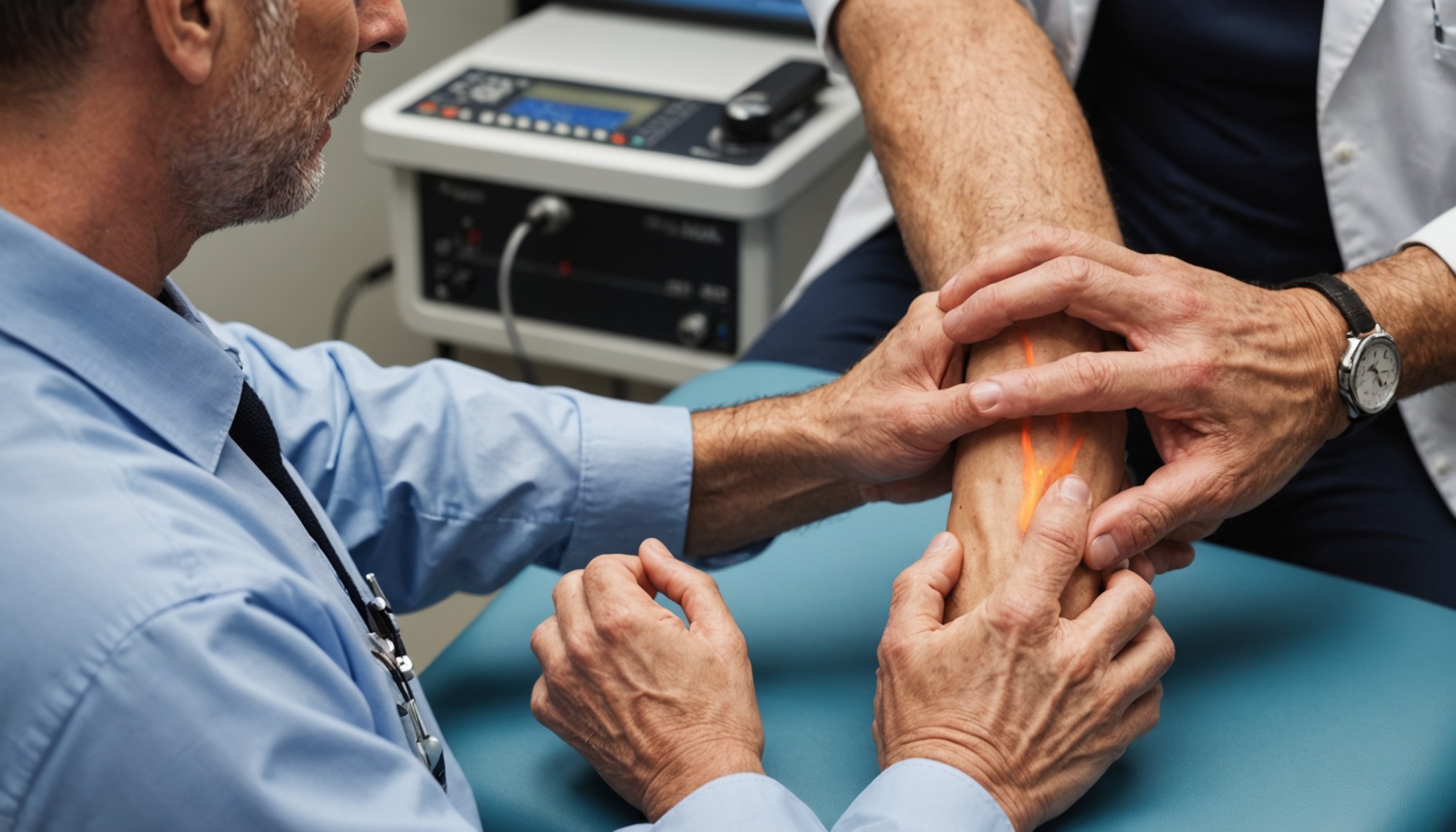The Importance of Ultrasound in Inflammatory Arthritis Detection
The advent of ultrasound technology in rheumatology has revolutionised the way healthcare professionals approach inflammatory arthritis detection. Unlike traditional imaging methods such as X-rays and MRI, ultrasound offers a real-time and dynamic evaluation of affected joints. This innovation allows clinicians to visualise synovial inflammation and other pathological structures with greater precision.
Early Detection Benefits
Early detection of inflammatory arthritis is pivotal for initiating timely interventions that can alter disease progression. Rheumatology innovations have underscored the importance of identifying diseases like rheumatoid arthritis at the earliest stages. Prompt diagnosis using ultrasound technology facilitates targeted treatments, potentially preventing long-term joint damage and improving patient outcomes.
Also read : Essential Strategies for UK Optometrists to Combat Rising Digital Eye Strain Among Young Adults
Comparison with Traditional Imaging
Compared to traditional imaging methods, ultrasound is not only less invasive but also more accessible and cost-effective. While X-rays are useful for detecting bone erosion, ultrasound provides a clearer image of soft tissues and early inflammatory changes. Unlike MRI, which is often more resource-intensive and time-consuming, ultrasound can be easily integrated into clinical practice, providing immediate feedback during consultations.
Such advancements in rheumatology innovations are crucial, as they ensure that patients benefit from the latest in medical technology, leading to more effective management of inflammatory arthritis. This evolution highlights the indispensable role of ultrasound in modern rheumatology.
Also to see : Boosting Recovery for Lung Transplant Patients: Innovative Minimally Invasive Techniques by UK Thoracic Surgeons
Recent Studies and Findings on Ultrasound Utilization
Recent research underscores the pivotal role of ultrasound technology in modern medical diagnostics. Several key studies affirm the effectiveness of ultrasound in enhancing diagnostic precision across various conditions. By providing real-time images, ultrasound allows medical professionals to make informed decisions swiftly, ensuring a conducive diagnostic accuracy.
Insights from recent studies demonstrate the high diagnostic accuracy in practice. For instance, in the field of obstetrics, ultrasound is renowned for its reliability in monitoring fetal development. It offers precise evaluations without the need for invasive procedures, fostering a safer patient experience. Similarly, in cardiology, recent research highlights its efficacy in assessing heart conditions swiftly and accurately, often leading to improved patient management strategies.
Furthermore, the evidence supports the notion that utilizing ultrasound can lead to improved health outcomes. Patients diagnosed using ultrasound benefit from quicker diagnosis times, which, in turn, can lead to more timely and effective treatments. The non-invasive nature of ultrasound also minimizes patient risk and discomfort, underscoring its appeal in diverse clinical settings.
Continued innovation and research into ultrasound technology promise to further enhance its diagnostic capabilities, reinforcing its integral role in patient care.
Benefits of Ultrasound Over Traditional Methods
Ultrasound technology provides significant benefits over traditional imaging methods, offering a superior real-time imaging capability. Unlike X-rays, which provide static images, ultrasound allows for dynamic assessment of structures, such as joints and soft tissues. This is invaluable in diagnosing conditions like arthritis, where movement and position changes can alter the structures being examined. Furthermore, while MRI is effective, its high cost and limited accessibility highlight the advantages of ultrasound.
Traditional imaging, such as MRI and X-rays, present certain limitations. X-rays are particularly limited in soft tissue imaging, frequently missing early indicators of conditions like arthritis. MRI, although effective, is often costly and less accessible to many patients, making ultrasound a more viable option for continuous monitoring and diagnosis.
Ultrasound shines in its cost-effectiveness and accessibility, offering an affordable diagnostic alternative that is widely available and can be used in various healthcare settings. This broad accessibility ensures that patients can receive timely and ongoing evaluation without the financial burden associated with other imaging options.
With these advantages, including accessibility and dynamic imaging, ultrasound stands out as a valuable tool in modern healthcare diagnostics, addressing both medical needs and economic constraints effectively.
Implementation of Ultrasound in UK Rheumatology Practices
The integration of ultrasound into UK rheumatology practices is transforming the landscape of patient care, enhancing diagnostic precision and treatment efficiency. This advancement encourages an exciting shift in how practitioners deliver healthcare. In healthcare practices across the UK, ultrasound is increasingly seen as an essential tool, aiding in the swift detection of rheumatological conditions.
How is ultrasound integration changing rheumatology? Ultrasound provides a non-invasive, immediate view into the body’s joints and tissues, allowing for more accurate diagnosis. This reduces the uncertainty in early disease stages and minimizes patients’ discomfort during invasive procedures.
But how does this affect healthcare professionals? Adequate training and education are paramount to successful integration. Initiatives have been set in motion to upskill current practitioners, ensuring they can harness the full potential of ultrasound technology. Training programs concentrate on enhancing technical skills and fostering a deeper comprehension of ultrasound diagnostics.
Patients in the UK have responded positively to ultrasound’s capabilities in diagnosing conditions more swiftly. While initial apprehensions existed, understanding its benefits has led to higher satisfaction and adherence to treatment plans. Thus, as UK rheumatology practices advance, ultrasound’s role becomes more prominent in shaping proactive, patient-centered healthcare solutions.
Case Studies Highlighting Successful Ultrasound Applications
Success in clinical settings often comes alive through tangible examples, providing clarity on what ultrasound technology can achieve. Consider the case studies where ultrasound was pivotal in guiding surgical procedures, like the removal of tumours. In such instances, precise imaging facilitated tumour excision while preserving critical tissues, significantly enhancing patient outcomes.
In another success story, physicians used ultrasound to manage cardiac conditions more effectively. By visualising heart function in real-time, doctors could tailor treatments that markedly improved recovery rates. This emphasis on the heart’s dynamics allowed interventions to be more precise, reducing patient recovery time.
From these case studies, lessons emerge about the critical role of ultrasound in medical practice. The technology’s ability to provide real-time insights has proven invaluable, particularly in enhancing decision-making processes. These insights translate into less invasive procedures, heightened precision, and ultimately, improved patient care.
Moreover, these case study analyses underscore the importance of practitioner expertise. A deep understanding of how to leverage ultrasound guidance effectively is essential, ensuring that the technology’s full potential is realised. Accordingly, these case studies become a cornerstone in educational settings, guiding future innovations in ultrasound application.
Expert Opinions on the Future of Ultrasound in Arthritis Detection
In recent years, expert insights have shed light on the evolving landscape of ultrasound technology in arthritis detection. Leading rheumatologists emphasize its potential in enhancing diagnostic accuracy. With technology advancements, ultrasounds offer real-time imaging that significantly aids rheumatologists in evaluating joint inflammation and damage.
Future trends suggest a broader acceptance of ultrasounds as a standard tool in arthritis diagnosis. Experts predict an increase in the integration of artificial intelligence (AI) with ultrasound, enabling deeper analysis and interpretation of imaging results. Such technological convergence could lead to more nuanced understanding and segmentation of joint conditions, facilitating tailored treatment plans.
Moreover, the potential integration with other technologies, such as magnetic resonance imaging (MRI) and augmented reality, is foreseeably transformative. These technology advancements in joint mapping could enhance visualization, allowing for comprehensive management of arthritis.
Rheumatologists believe that as these innovations advance, not only will diagnostic accuracy improve, but there may also be a noticeable shift towards more personalised patient care. This underscores the critical role of ultrasound in future diagnostic practices and patient outcomes, demonstrating its value as a cornerstone technology in managing arthritis.
Challenges and Limitations of Ultrasound in Inflammatory Arthritis Detection
Ultrasound technology offers detailed imaging, yet it faces several challenges in clinical practice. One primary limitation is its operator dependency, which can lead to inconsistent results. For instance, the interpretation depends on the clinician’s expertise, potentially affecting diagnostic accuracy.
In specific patient populations or conditions, there are notable limitations. For patients with obesity, for example, ultrasound’s penetration depth may be inadequate, impacting image quality and diagnostic reliability. Similarly, in severe cases of inflammatory arthritis, heavy joint calcification may hinder the ultrasound’s ability to provide clear images.
There are also misconceptions regarding the use of ultrasound in detecting inflammatory arthritis, which act as barriers to its widespread adoption. Some healthcare providers may underestimate its sensitivity compared to MRI or believe that it cannot detect early inflammatory changes. However, when correctly deployed, ultrasound can identify early signs of inflammation with high precision.
Addressing these challenges involves ongoing training for healthcare professionals to ensure proficiency and confidence. By doing so, the limitations of ultrasound technology can be mitigated, enhancing its role in early diagnosis and management of inflammatory arthritis. Additionally, patient-specific strategies could optimize imaging quality even in challenging cases.
The Impact of Improved Detection on Patient Management and Outcomes
Enhancing patient management begins with early and accurate detection. When diseases are identified at an early stage, treatment outcomes significantly improve. This is because early diagnosis allows for timely intervention, enabling tailored treatment plans that are more effective and less invasive. The result is quicker patient recovery and a better quality of life.
Ultrasound-guided diagnosis plays a critical role in this process. Its precision and non-invasiveness mean that it can detect abnormalities that might be missed by other methods. This improved detection capability correlates with enhanced treatment outcomes. With accurate imaging, healthcare providers can devise more targeted and successful treatment strategies, reducing the risk of complications and promoting swift recovery.
Looking to the future, these advancements in detection promise to revolutionise overall patient care strategies. As technology evolves, the potential for even greater precision in diagnosis and treatment planning will shape the field of medicine. The focus will increasingly be on personalised care, empowering healthcare professionals to manage diseases more effectively and improve patient prognosis. This transformation signifies a promising leap forward in medicine, accentuating the importance of integrating sophisticated detection tools in routine clinical practice.











